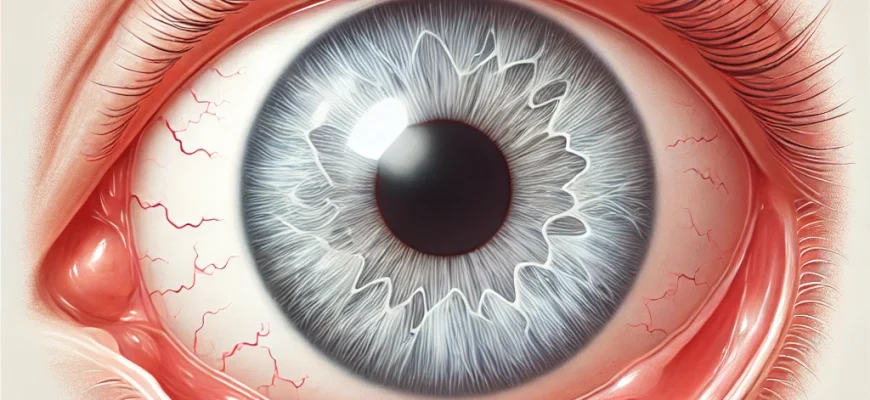Fuchs’ dystrophy is not just a medical term; it represents a daily struggle for many, affecting their vision and quality of life. Despite being a condition that impacts thousands, it remains largely misunderstood by those outside the ophthalmology community. Let’s demystify Fuchs’ dystrophy by diving into the symptoms, the latest advancements in treatment, and what you can do if you or someone you love is navigating life with this condition.
What is Fuchs’ Dystrophy? The Basics Explained
Fuchs’ dystrophy is an eye disorder that affects the cornea, the clear dome at the front of the eye. It specifically impacts the endothelial cells—the cells responsible for keeping the cornea clear by pumping out excess fluid. When these cells deteriorate, fluid builds up, resulting in swelling, cloudy vision, and ultimately, reduced sight.
Recent estimates suggest that 4% of people over the age of 40 in the United States have early signs of Fuchs’ dystrophy, though not all will experience significant symptoms. Women are about three times more likely than men to develop this condition, a fact that has spurred ongoing research into possible genetic and hormonal links.
The condition typically presents itself in two stages. The early stage, where endothelial cells start to die but symptoms may be minimal, is often referred to as Stage 1. By Stage 2, symptoms become more apparent as the cornea swells and vision becomes blurred, especially in the morning.
Symptoms to Watch For
Fuchs’ dystrophy can be hard to identify early without regular eye exams, but here are some of the hallmark symptoms:
- Blurry vision, especially upon waking up
- Glare sensitivity, often from oncoming headlights at night
- Halos around lights
- A gritty sensation, almost like there’s something in the eye
- Vision that gradually improves throughout the day (due to corneal fluid reduction)
These symptoms can be subtle at first, but they worsen over time. By the time Stage 2 sets in, patients may find daily tasks—like reading, driving, or even recognizing faces—challenging. Dr. Hannah Rivera, an ophthalmologist specializing in corneal diseases, explains, “The most telling symptom of advanced Fuchs’ is the visual clarity improving as the day progresses, a phenomenon related to fluid evaporation during waking hours.”
The Impact on Daily Life: Not Just Physical
The effects of Fuchs’ dystrophy extend beyond just the physical. It’s about the gradual, emotional toll that declining vision takes on someone’s ability to stay independent. A survey conducted in 2023 by the American Academy of Ophthalmology found that nearly one in five patients with Fuchs’ dystrophy reported feelings of anxiety due to their vision problems. The uncertainty surrounding their ability to perform tasks like driving or cooking significantly impacted their quality of life.
“I was terrified of losing my independence,” shares Margaret, 62, who was diagnosed five years ago. “The mornings were the worst, and I found myself dreading them. It wasn’t just about blurry vision; it was about losing control.” Her experience is echoed by many who face the challenge of managing fluctuating vision.
Modern Treatments: From Drops to Surgery
While there is no outright cure for Fuchs’ dystrophy, there are several effective treatments that can help manage symptoms and slow progression. Let’s break down what’s available:
1. Saline Drops and Ointments
In the early stages, hypertonic saline drops and ointments can help draw out excess fluid from the cornea. This can temporarily improve morning vision and reduce swelling.
- Average Cost: Around $15 to $30 per bottle, depending on brand.
2. Corneal Transplantation
For advanced Fuchs’ dystrophy, a partial corneal transplant is often recommended. A procedure known as Descemet’s Stripping Endothelial Keratoplasty (DSEK) or the more recent Descemet Membrane Endothelial Keratoplasty (DMEK) involves replacing the damaged endothelial layer with healthy donor tissue. DMEK, in particular, has shown better outcomes with faster recovery and improved visual clarity.
- Success Rate: Over 95% for improved vision, according to a 2022 study from Johns Hopkins University.
- Cost Estimate: Between $4,000 and $10,000 per eye, depending on surgeon fees and facility costs.
| Treatment | Description | Cost Estimate (USD) |
|---|---|---|
| Hypertonic Saline Drops | Helps reduce morning swelling | $15 – $30 per bottle |
| DSEK/DMEK Surgery | Replaces damaged corneal layer | $4,000 – $10,000 per eye |
3. Emerging Treatments: Rho Kinase Inhibitors
A promising area of research involves Rho kinase inhibitors. These are eye drops that help endothelial cells regenerate. Currently, these treatments are still in clinical trials, but preliminary results have been optimistic, with up to 30% of patients showing an improvement in corneal clarity after six months of use.
“Rho kinase inhibitors are showing real potential for delaying the need for surgical intervention,” says Dr. Rivera. “It’s the first real non-surgical hope we’ve seen for managing advanced Fuchs’ dystrophy.”
Prevention Tips and Lifestyle Adjustments
Although Fuchs’ dystrophy cannot be prevented, certain lifestyle adjustments can help minimize symptoms and prevent further damage.
- Stop Smoking and Alcohol: Smoking and alcohol consumption can exacerbate corneal inflammation. Complete abstinence is crucial for anyone managing corneal health.
- Humidify Your Environment: Using a humidifier in your home can help keep your eyes from drying out overnight. This can reduce the severity of morning symptoms.
- Sunglasses: Always wear sunglasses when outside. UV protection helps protect corneal cells from additional stress and damage.
Advice from Our Editorial Team
Fuchs’ dystrophy is challenging, but it doesn’t have to mean the end of an active, independent life. The key is regular eye check-ups—early diagnosis means early intervention, and that can make all the difference. If you or a loved one notices persistent blurry vision in the mornings, it’s time to see an ophthalmologist.
Simple measures like using saline drops, keeping your living space humidified, and avoiding known irritants (like smoking) can help manage symptoms effectively. Remember, medical advances are constantly evolving, and with promising treatments on the horizon, there is every reason to stay hopeful. Stay proactive, stay informed, and always prioritize your eye health.









